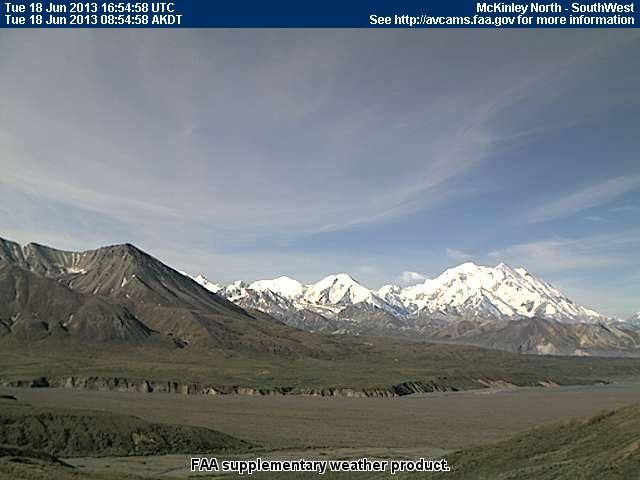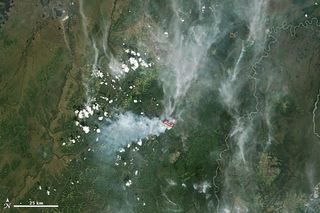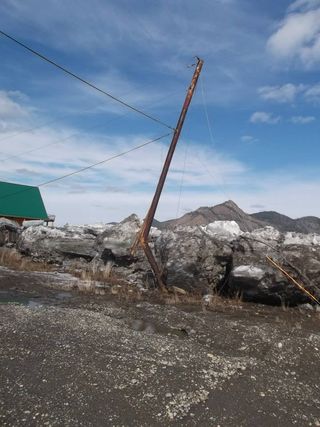Baked Alaska: Crazy Weather Swings from Ice to Fire

In Alaska, houses are built to keep warm air in and cold air out, not the other way around. So with a record-setting heat wave scorching the state, residents are sweltering amidst temperatures soaring past 90 degrees Fahrenheit (32 degrees Celsius).
Southcentral Alaska hit four all-time highs yesterday (June 17), ranging between 88 F (31 C) in Seward to 94 F (34 C) in Talkeetna, according to the National Weather Service's Alaska forecast office. In the southeastern portion of the state, Skagway, a popular cruise ship port-of-call, reached 83 F (28 C), almost as warm as St. Thomas in the Virgin Islands. Just about every part of the state was warmer than average yesterday, the NWS said.
The blazing hot temperatures are just the latest records to fall this year in Alaska. Residents also endured history-making cold temperatures throughout spring and flooding and evacuations caused by the never-ending winter. A mass of Arctic air stuck over the state for weeks this spring was responsible for the chilly weather. It finally fell prey to the warming effects of 18 hours of sunlight at the end of May. [The 9 Hottest Places on Earth]
"Eventually, the sun is going to win out, and once it did, boy, did things change in a hurry," said Michael Lawson, a meteorologist with the NWS Alaska forecast office in Anchorage.
Marine layer loses
While Interior Alaska and towns near the Alaska Range regularly see high temperatures in the summer, extreme heat rarely flares up in Alaska's coastal communities, which are cooled by marine breezes. But a high-pressure ridge parked over Southcentral Alaska is pushing refreshing afternoon sea breezes offshore.

A similar predicament often develops in Southern California, when a high-pressure system keeps the Catalina Eddy offshore, firing up heat waves in beach towns that depend on fog and ocean air for natural air-conditioning.
Sign up for the Live Science daily newsletter now
Get the world’s most fascinating discoveries delivered straight to your inbox.
"It's really much rarer for places in Southcentral Alaska to get as hot as they've been getting," Lawson told LiveScience. "This ridge has been so strong the sea breeze hasn't been getting a chance to cool us down."
The heat wave will continue for the rest of the week, the NWS forecasts. The unusually strong, high-pressure system is intensifying over mainland Alaska, continuing the heat wave. Interior and Southwest Alaska will reach upwards of 90 F (32 C), and Southeast and Southcentral Alaska will see highs in the upper 70s and 80s F (between about 21 and 26 C).
A year without a spring

Yet just a month ago, Alaska was in the grips of a never-ending winter, with late-season snowstorms and record-low temperatures in mid-May. The wild weather swing has wreaked havoc on the annual ice melt along rivers, causing ice jams and flooding. The town of Galena was evacuated late last month due to flooding from an ice dam on the mighty Yukon River. The Nenana Ice Classic, a betting contest on the Nenana River's ice breakup, set a record for the latest-ever crack and cave in of the ice.
"It was an incredibly rapid transition," Lawson told LiveScience. "Literally, our spring was about five days before we jumped into summer-type weather."
A persistent low-pressure trough that remained stuck over the state brought wave after wave of cold Arctic air into Alaska, Lawson said, keeping temperatures lower than normal for most of the winter.
This week's warm weather could bring more flooding from melting snow and ice at higher elevations, the NWS has warned. A red flag fire warning, which signals dangerously dry air and possible strong winds, was also issued over the weekend for much of the state because of drier conditions caused by the hot air mass. A forest fire broke out east of Fairbanks on Monday evening (June 17), prompting temporary road closures. A 30,000-acre fire is also burning in Southwest Alaska.
The highest temperature ever recorded in Alaska was 100 F (37 C) in Ft. Yukon on June 27, 1915.
Email Becky Oskin or follow her @beckyoskin. Follow us @livescience, Facebook & Google+. Original article on LiveScience.com.












